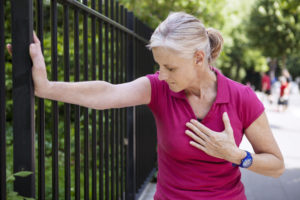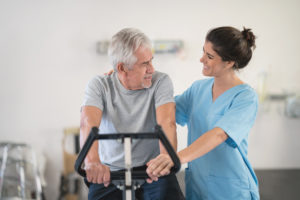This post is sponsored by the Live Better campaign, a project of the non-profit American Thoracic Society. Opinions are my own.
My late mother-in-law Gerry was slender, ate super sensibly, and played tennis into her late 70s, but she never again picked up a racket when she began having breathing difficulties and was diagnosed with COPD (chronic obstructive pulmonary disease). Although she was under the care of a prominent pulmonary specialist in New York, he failed to tell her about a proven treatment that would have reduced her symptoms and enhanced the quality of her life. Distressing!
 The third-leading disease-related cause of death in the United States behind heart disease and cancer, chronic lower respiratory diseases, such as COPD, affect approximately 16 million people, reported the Centers for Disease Control and Prevention. And, it’s the only cause of death that’s on the rise. Even more alarming, it’s estimated that as many as 14 million additional cases are undiagnosed because sufferers don’t speak up about their symptoms and don’t see health professionals.
The third-leading disease-related cause of death in the United States behind heart disease and cancer, chronic lower respiratory diseases, such as COPD, affect approximately 16 million people, reported the Centers for Disease Control and Prevention. And, it’s the only cause of death that’s on the rise. Even more alarming, it’s estimated that as many as 14 million additional cases are undiagnosed because sufferers don’t speak up about their symptoms and don’t see health professionals.
Shockingly, 62 percent of those diagnosed with chronic pulmonary disorders don’t know about pulmonary rehabilitation, a safe exercise and education program that improves patients’ exercise capacity and decreases symptoms, revealed a survey commissioned by the American Thoracic Society (ATS). And, symptoms can be severe, often preventing patients from even walking from one side of their home to the other, preparing meals, or washing their own hair, said Dr. Carolyn L. Rochester, professor of medicine, pulmonary critical care and sleep medicine at the Yale University School of Medicine.
 The 500 patients who participated in the survey of patient attitudes, conducted by Wakefield Research, suffered from either COPD or pulmonary hypertension, interstitial lung disease, and other chronic pulmonary disorders. Although almost two-thirds of them had never heard of pulmonary rehabilitation, 70 percent did know about oxygen therapy and 61 percent knew about medicinal interventions such as long-acting inhalers. While only 38 percent of patients know about pulmonary rehabilitation, a study of patient data reported that only 1.9 percent of those hospitalized for COPD actually received it within six months of their discharge.
The 500 patients who participated in the survey of patient attitudes, conducted by Wakefield Research, suffered from either COPD or pulmonary hypertension, interstitial lung disease, and other chronic pulmonary disorders. Although almost two-thirds of them had never heard of pulmonary rehabilitation, 70 percent did know about oxygen therapy and 61 percent knew about medicinal interventions such as long-acting inhalers. While only 38 percent of patients know about pulmonary rehabilitation, a study of patient data reported that only 1.9 percent of those hospitalized for COPD actually received it within six months of their discharge.
How — And Why — Pulmonary Rehab Works
Although chronic respiratory diseases can’t be cured, they are manageable. Pulmonary rehab, a comprehensive six- to 12-week program, uses breathing techniques and gentle, supervised exercise that strengthens the muscles to ease the burden on the lungs and teaches patients how to manage their breathing. They not only feel better, but can resume many activities they’ve been avoiding. Fifty-seven percent of the survey respondents said they’d stopped climbing stairs, half didn’t carry anything when they walked, and 43 percent didn’t leave their homes to do errands such as grocery shopping.
“Shortness of breath causes COPD patients to become sedentary and out of shape, which only worsens their shortness of breath. Pulmonary rehabilitation gives people the tools to manage the disease themselves,” Dr. Rochester explained.
Why Patients Don’t Know About This Proven Treatment
Ignorance isn’t bliss for COPD patients, and one of the primary reasons they’re uneducated about pulmonary rehabilitation as an effective treatment option is that many don’t talk about their disease to their families or healthcare providers. Some patients are or were smokers who suffer their symptoms in silence. Some are embarrassed by their habit or resigned that they’ll never be able to quit, let alone feel better. Even when patients are diagnosed with COPD, 40 percent don’t know that their condition is life-threatening, according to the ATS survey. In fact, participants ranked stroke, diabetes and Alzheimer’s over chronic respiratory diseases as leading causes of death.
 Complicating the problem is the simple fact that doctors — like my mother-in-law’s — may not be familiar with the latest science on pulmonary rehab. Or perhaps they aren’t sure about reimbursement, the referral process or whether there are programs in their area.
Complicating the problem is the simple fact that doctors — like my mother-in-law’s — may not be familiar with the latest science on pulmonary rehab. Or perhaps they aren’t sure about reimbursement, the referral process or whether there are programs in their area.
Pulmonary rehabilitation is safe, effective, and often covered by Medicare or the patient’s insurance, emphasized Chris Garvey, a nurse practitioner at University of California in San Francisco who has been coordinating pulmonary rehabilitation programs for over 25 years. Patients often are treated with long-acting maintenance inhalers, yet pulmonary rehab is not recommended, Garvey added; however, rehabilitation is ultimately more helpful in terms of reversing both frailty and musculoskeletal dysfunction.
Pulmonary rehabilitation has been established as the standard of care “to improve shortness of breath, functional capacity, ability to exercise and be active, as well as quality of life and mood, including depression and anxiety in persons with chronic lung disease,” Garvey emphasized. Even patients with severe COPD can benefit from rehabilitation, she added.
“Living Your Life Again”
“It’s critical to raise awareness of pulmonary rehab, which is similar to cardiac rehabilitation for patients with chronic heart conditions, so that individuals can advocate for themselves,” said Dr. Rochester. Consider the experience of Lynn Markwell, who completed pulmonary rehab a year after being diagnosed with interstitial lung disease. “I was told I didn’t have long to live, but if you do the exercises, learn to manage your breathing and know your medications, you can feel better and start living your life again.”
Although it saddens me that my mother-in-law didn’t know about pulmonary rehabilitation, I am pleased to get behind the ATS campaign to help spread the word. Anyone with chronic lung disease deserves to access a treatment option that no one ever offered to my mother-in-law.
Learn more about pulmonary rehabilitation and find a program located near you at livebetter.org

PS And be sure to head to the FabOverFifty Facebook page next Wednesday, February 27th, at 1 pm ET, when we’ll be live at Mount Sinai Hospital in New York to show you, first-hand, pulmonary rehab at work!

